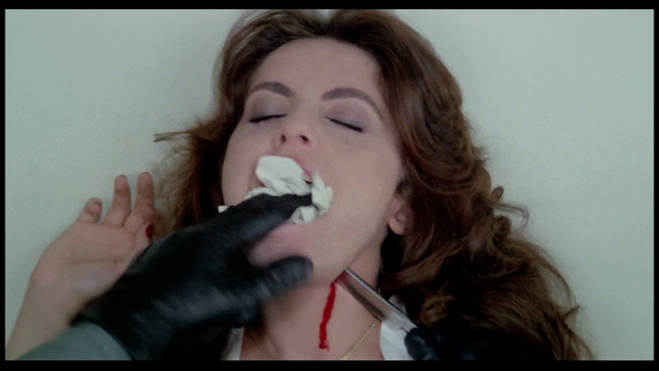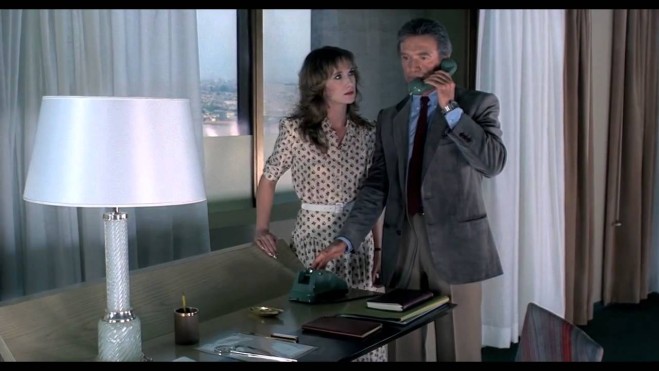
Though I had a good time participating in Shocktober for the first time last year, most of the movies I reviewed were immense pieces of crap (like Kingdom Of Spiders) or reintroductions to films I already knew I was a fan of (Eraserhead). However, the one real discovery last year was the film Deep Red, directed by Dario Argento, which featured a potent mix of Hitchcockian craftsmanship, pulpy violence, and funky ’70s tunes via horror-rockers Goblin. And considering John got to review both an Argento movie this Shocktober (and last), I feel like we’re both having a pretty good time discovering the work of this essential Italian horror director, and the man perhaps most associated the giallo subgenre. After venturing into somewhat less giallo-y territory in the late ’70s, 1982’s Tenebre saw the director returning to his gory murder-mystery roots, and in the process proving the ‘ol bloodhound still had it.
The film centers on Peter Neal (played by Anthony Franciosa), an American writer of violent crime/horror novels, who has just landed in Rome on a book tour. Shortly after he arrives, a young woman is caught shoplifting a copy of Neal’s latest book, Tenebre. She is then murdered by an unseen psychopath (though they’re clearly a connoisseur of leather gloves and straight-edge razors), and with these gloves is seen shoving pages of Neal’s book into the woman’s mouth as she’s being murdered. Neal then gets a letter from this crazed murderer, saying that his books and their over-the-top violence has been the inspiration for their murders, which draws the attention of a detective (Giulianni Gemma) who pretty much doesn’t know shit and is never even remotely close to figure out who the murderer is. We then get a varied series of grizzly killings, while the film doesn’t give us much clue as to who this murderer is, other than a telling moment where Neal quotes Sir Arthur Conan Doyle, saying “when you have eliminated the impossible, whatever remains, however improbable, must be the truth.”
First of all, the device of a guy who makes pulpy, possibly misogynist horror novels, is a pretty clever piece of meta-commentary on Argento’s own tendencies as an artist, and the movie definitely has a good deal of fun with that. Which, I’m not even sure if a lot of Argento’s movies come off as disrespectful of women, but a sassy reporter says that Neal’s books are, and it is kind of hard to place exactly where the film falls on the feminist/misogynist scale, since there are a lot of female characters in this film, to the point where it almost felt like an Almodovar horror film (although, I guess that’s what The Skin I Live In was). Though we do see a lot of these women brutally killed in this movie, while a lot of the time the film seems to take a kind of sick pleasure in their bloody demise. And yet at the same time, the killer appears to be a woman, due to her huskily feminine voice, which we hear in a few passing moments. Also, the film takes a refreshing approach in letting each female character be given some depth of personality and nuance before they’re brutally murdered. So I don’t know, it feels like the movie is having its cake and savoring it too. Whatever that means.
I feel like this was also a big component of Deep Red (and probably Suspiria too), and maybe Dario Argento’s filmography as a whole, but this film makes it apparent that the man sure knows how to use a spooky dolly shot. There’s this weird, almost signature way that the camera will move around, which will usually be accompanied by some sort of eery musical cue that will tell you that something terrible is about to happen. The most impressive of these in Tenebre involves this long shot in which the camera swoops all the way around this house in which the young reporter Tilde, along with her female lover are eventually murdered (and yes, the addition of lesbians being killed makes the film’s gender politics even less easy to definitively understand). At first you do have to wonder why the camera is spending so much time lingering on this house, and then after a while you realize, “Oh, yup. This is not going to end well.”
After the more supernatural horror of 1977’s Suspiria and 1980’s Inferno (the latter of which was a bit of a flop), Tenebre was an attempt by Argento to return to his roots, and because of that it feels a bit like a film out of time. A big reason for this probably has to do with it (like much of Argento’s early films) having that Hitchcock-inspired quality to it, and thus often feeling like it takes place in the ’50s (there’s a character that more often than not is seen wearing a fedora). And yet there’s also that score, which wasn’t done by Argento’s frequent collaborators Goblin (since the band had broken up by this point), but was done by three of the band’s members (the score is attributed to Simonetti-Pignatelli-Morante) and thus feels a lot like an Argento film from the mid-70s. Which you’d think would make the film feel out of touch, since it absolutely does not feel like it takes place in the 1980s, and yet there’s something so potent about this taught meditation on masochistic perversion and its repercussions, that the movie gets away with it.
Now, even though I am complimenting the film for it’s more meta/self-examinatory qualities and it’s elegant use of camera, I still feel like I have to reinstate how god-damn bloody this film is. And sure, some of the murders leave something to the imagination, though some, well don’t, and just sort of linger on how much fake blood you can make ooze out of a fresh synthetic corpse. It’s this very disarming combination of class and trash that’s at the heart of Argento’s M.O. as a director, and which is dissected pretty cleverly in Tenebre. Now, I’m not sure if this was his last great film before the inevitable late-career auteur decline, but I’ll just say it was, since I’m tired and it’s late and doing any more research sounds about as much fun as having my throat slit open.


